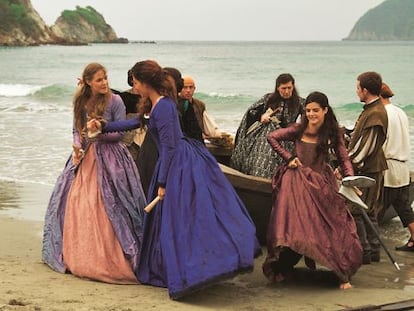Anna Maria: The Spaniard who survived 16 bayonet wounds during the Battle of Manila
In 1945, when she was just a girl, ‘Anita’ watched Japanese troops kill her parents and siblings. But she remembers nothing of what happened in the Philippines, choosing to focus on her second life after the atrocity
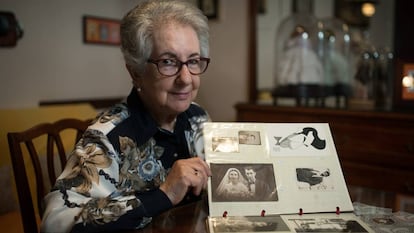

Anna Maria Aguilella’s life began again when she was seven years old. That day, in 1946, in a large apartment in Elisabets street in Barcelona, she started to form memories of a childhood with a loving grandmother and the constant bustle of uncles and cousins. When Anna Maria finished school, she joined a cultural academy. As she recalls, she was 16 years old when she was employed as a typist at an insurance company, and 26 when she married Fernando, a salesman, with whom she had two children. His death in 1998 devastated her. She began to suffer from depression, which eased over time into a placid old age. Now, at 82 years of age, Anna Maria, “in good health, although with some normal ailments from getting older,” is speaking to EL PAÍS from her home in the Barcelona neighborhood of La Ribera.
But when Anna Maria talks about her past, it is this second life that she remembers. Of the earlier life she lived and survived, she has no memory. But her body has kept a record: she has marks and scars from 16 bayonet wounds. They are a reminder that she was witness to an atrocity.
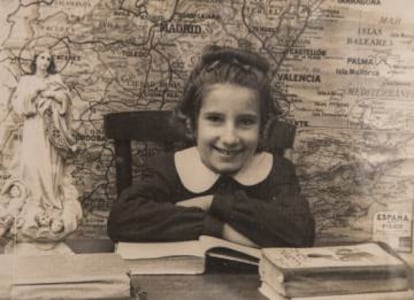
Anna Maria’s first life began in Cebu City in the Philippines on August 23, 1938. That was the day she was brought into the world by her mother Aurora, the daughter of two Catalans from Cerdanyola del Vallès who had immigrated to the Philippines to work in copra, the dried kernel of the coconut which is used in soaps and oils. Her father, Plácido Antonio, had left Onda in the Spanish province of Castellón to work for the prosperous General Tobacco Company of the Philippines (CdF), the first Spanish multinational. In the end, the family moved to Cavite, south of the capital Manila, where speaking Spanish did not clash so much with chabacano, the creole language spoken by the local population.
The family were very close to the so-called “Mesticería” neighborhoods of Manila, where many Spaniards and Spanish-speaking Filipinos gathered and lived. The Philippines hadn’t been a Spanish territory since 1898, but this fact was less obvious in the capital, where Spanish-speakers went to the same churches, read newspapers in Spanish, watched Spanish-language films, attended sarswelas (the local variation of zarzuelas, Spain’s popular operettas) and attended games of Basque pelota, a traditional court sport from Basque Country. “The richest man in the Philippines, Andrés Soriano, the owner of the San Miguel brewery, was Spanish,” says Florentino Rodao, history professor at Madrid’s Complutense University and the author of the book Franco y El Imperio Japonés (or, Franco and the Japanese Empire).
The Second World War breaks out in 1939. The close relationship between Spanish dictator Francisco Franco and the Axis powers encourages supporters of Spain’s fascist Falange party in Manila – who greatly outnumber Republicans – to welcome the arrival of Japanese troops in the city in 1942. Three years later, US General Douglas MacArthur will try to take the capital from the north. The cost of the conflict, known as the Battle of Manila, or the Rape of Manila, will leave 100,000 people dead and completely devastate the city. Manila will go down in history as the hardest hit of all the Asian capitals during the Second World War.
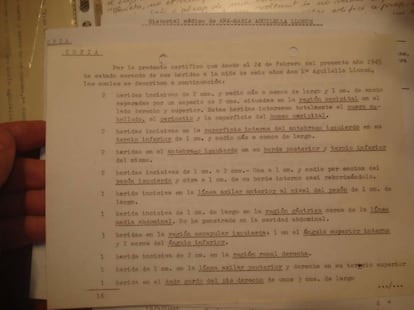
The devastation of Manila is a huge blow to Spanish culture on the island. “For the Hispanic-Filipino culture, it was a true disaster,” says Benito Legarde, a veteran Spanish-speaking historian, who lived in the conflict zone during the Battle of Manila and escaped unharmed. “The most-affected areas of the city were where Spanish-speakers lived, they suffered many losses and many survivors were ruined and left the country for Spain or America. The Spanish press, which had previously had such a strong influence on social and political life, disappeared.”
During the clashes of the month-long battle, crossfire on the streets is common. The Americans are bombing from the air. The Japanese are focusing on Spanish-speaking residents in the Intramuros neighborhood. The bridges of some of the oldest religious and military buildings in Manila are destroyed. Civilians are locked up in inhumane conditions, each given just 140 grams of rice to survive on each day. Some 800 people are assassinated in the German consulate. The group had taken refuge on the mistaken idea that the link between the Axis powers and imperial Japan would protect them.
I had a new life, I no longer thought about the old one. Everything was erasedAnna Maria Aguilella, Battle of Manila survivor
“All my days have been spent subjugating the natives and the soldiers. I have already killed more than 100 people,” a Japanese soldier wrote in his diary in February 1945. “The simplicity of my native people disappeared a long time ago. Now I am a cruel killer and my bayonet is always bathed in blood. It is for my country, but it is atrocious. Forgive me, God. Forgive me, mother.”
Anna Maria saw this cruelty first hand. Spaniards and Hispanic-Filipinos did not want to leave their homes and businesses, fearing that they would be looted, and just as the German residents had sought shelter in the Germany consulate, between 50 and 70 people, including some Spanish families, took refuge in the Spanish consulate. Aurora and Plácido Antonio go there with their three children: nine-year-old María del Carmen, two-year-old Jaime and seven-year-old Anna Maria. It was a terrible mistake.
“Do you remember anything?” a journalist from the Diario de Barcelona asks Anna Maria a year-and-a-half after the battle.
“Yes, sir. I will never forget the four Japanese men from that night. We were in the consulate and they entered with bayonets: they killed everyone,” she replies.
“And you were aware of everything that was happening?”
“I was already seven years old.”
“That’s not very old.”
“But I understood.”
“And did you know why the Japanese were coming?”
“Father figured it out. They killed them in front of me. I ran away and was able to escape.”
“It would be difficult for this girl to erase such a terrible memory of events she experienced. Her countenance indicates the terrible suffering she has suffered,” the article in the Diario de Barcelona reads.
Although difficult, it is what happened. “I never asked my grandmother about it at home,” explains Anna Maria by phone. “There were lots of photos of my parents. They didn’t even tell me they were dead. There was complete silence. I didn’t concern myself either: I had a new life, I no longer thought about the old one. Everything was erased. Nor have I been very interested [in the subject], I haven’t tried to read about it. It doesn’t interest me,” she says. “I haven’t returned to the Philippines, nor do I want to.”
Anna Maria did, however, agree to be part of the documentary De Aliados a Masacrados. Los últimos de Filipinas (or, From Allies to Massacre Victims: The last Filipinos) by journalist Ramon Vilaró, which recounts the story of her survival on February 12, 1945 and the terrible retreat of the Japanese in Manila. In the documentary, Anita Maria explains how she pretended to be dead.
“The Japanese entered, they lined us all up, children in front and the elderly behind, and they bayoneted all of us. They thought I was dead, after 16 injuries, with one of them, the most serious, to the head. But it was not my time, and I survived two days among the dead. No one left there. I was born twice,” she says.
The bodies of her parents and siblings were left in a burning building. Today they rest in San Agustín church, the only Spanish building in Intramuros that remained standing.
An Australian neighbor, who lived in the house next door, picked up Anita Maria and took her to a Spanish woman, who brought her to the Spanish consulate. In the end, the consulate was able to track down her only uncle, and Anita Maria went to live with him and his five children. One year later, they all boarded the ship Plus Ultra, which Spain had chartered to repatriate 220 Spaniards. On June 5, 1946, the Spaniards were met in the port of Barcelona by nearly all authorities, including the civil governor and the general capital of the Fourth Military Region. A crowd of people is there to welcome them, waving white handkerchiefs. Some have even offered to drive the passengers once they reach land. The cameras of the state-controlled Noticias y Documentales newsreels focus on the passengers disembarking under a sign reading “Long live Spain, long live Franco.” Anita Maria has a serious face. She has a white ribbon tied around her short hair. From this day on, she will live with her grandmother. She is lucky. The other orphans who have traveled with her will be placed in social care.
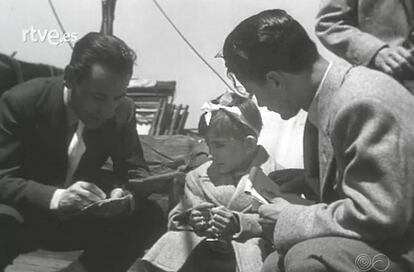
Francisco Franco took advantage of Japan’s aggression in the Philippines. “In 1945, Franco was making very obvious gestures to get close to the Allies and had the support of the ambassador Carlton J. H. Hayes, who just returned from the United States,” explains Florentino Rodao. Two years earlier, the dictator and the ambassador had held an important meeting at Pazo de Meirás, a manor hours in A Coruña province in Galicia. At that meeting, “Franco proved his anti-Japan sentiments. He put forward a strange theory that three wars were happening at once: the one between the Allies and the Axis powers, in which Spain was theoretically neutral; the one between the Axis powers against communism, in which Spain backed the Axis power; and the one between the United States and Japan, in which Spain supported the United States.”
According to Rodao, the Spanish response to the massacre at the Spanish consulate allowed it to show that Spain was on the side of the Allies and even to be invited to the San Francisco Conference, which was the origin of the United Nations. “It was a coordinated effort. In the United States, [Ambassador Carlon J. H.] Hayes encouraged the publication of an article favorable to the dictator in Newsweek. In Spain, Franco not only suddenly granted freedom of the press foreign correspondents, but also took the first step in breaking ties with imperial Japan: he stopped representing Japan’s interest in the American continent.”
Anna Maria is part of this history, but she grew up ignoring it. Not even the image of her parents and siblings or the terror of watching them be killed have escaped her amnesia. Not one single memory from her first life has survived. What has survived are certain fears. Her daughter, 51-year-old Esther Fernández Aguilella, says her mother cannot stand crowds. “She cannot go to places where there are lots of people because she feels overwhelmed. Nor can she go to [Barcelona’s popular tourist area] Las Ramblas, or to the cinema or theater.”
Anna Maria also has a fear of Asian men, but this phobia has since subsided. In a 2002 interview with Spanish newspaper La Vanguardia, Anna Maria explains: “When I was little, I couldn’t stand seeing Japanese people. Not even in films. I would cover my eyes and hope to become invisible if I crossed paths with one. Just with men, I never felt that way with women. Now I don’t feel anything more than indifference.”
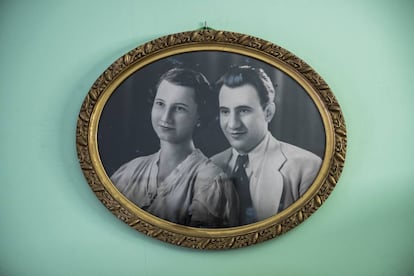
In 2010, thanks to an introduction from Florentino Rodao, Anna Maria opened the doors to her home to a young student from Tokyo University – she was the first Japanese person Anna Maria had spoken to in 65 years. The student, Chikako Arasawa had read in the news that a survivor from the Manila massacre was still alive. She wanted to meet Anna Maria and was warmly welcomed into her life. The young Japanese woman spoke not only about history, but was also interested in Anna Maria’s life and children. “This Japanese woman is giving me life,” Ana Maria told Rodao. “Right at the moment of the disaster, which has influenced all of her life, Anna found the strength to continue living,” Arawasa says from Tokyo, where she will soon present a doctoral thesis about the testimony of witnesses to historical events as a source of academic research. “Her resilience, she told me, had been her herself.”
Anna Maria’s two children are aware of their mother’s history. “The massacre was not taboo, but we didn’t talk about it much at home,” says her son, 49-year-old Jaume Fernández Aguilella. Of all the stories his mother told him when he was little, one image has lingered. A young girl, with a white ribbon in her hair, surrounded by journalists jotting down notes. It’s an image from the news story in 1946, when the Plus Ultra arrived in Barcelona. Before the repatriated passengers are reunited with their family members, a journalist asks a young Anna Maria if anyone is waiting for her.
“I don’t know,” she replies. “My grandmother perhaps.”
“Does she know you?”
“No, nor do I know her.”
“So?”
“But with this she will know who I am, right?”
“This” was a photo of her mother.
English version by Melissa Kitson.
